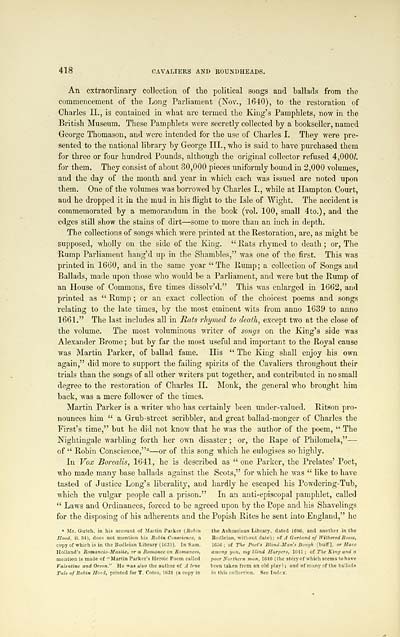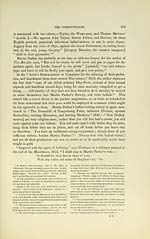Glen Collection of printed music > Printed text > Popular music of the olden time > Volume 2
(42) Page 418
Download files
Complete book:
Individual page:
Thumbnail gallery: Grid view | List view

418 CAVALIERS AND ROUNDHEADS.
An extraordinary collection of the political songs and ballads from the
commencement of the Long Parliament (Nov., 1640), to the restoration of
Charles IT., is contained in what are termed the King's Pamphlets, now in the
British Museum. These Pamphlets were secretly collected by a bookseller, named
George Thomason, and were intended for the use of Charles I. They were pre-
sented to the national library by George III., who is said to have purchased them
for three or four hundred Pounds, although the original collector refused 4,000/.
for them. They consist of about 30,000 pieces uniformly bound in 2,000 volumes,
and the day of the month and year in which each was issued are noted upon
them. One of the volumes was borrowed by Charles I., while at Hampton Court,
and he dropped it in the mud in his flight to the Isle of Wight. The accident is
commemorated by a memorandum in the book (vol. 100, small 4to.), and the
edges still show the stains of dirt — some to more than an inch in depth.
The collections of songs which were printed at the Restoration, are, as might be
supposed, wholly on the side of the King. " Rats rhymed to death ; or, The
Rump Parliament hang'd up in the Shambles," was one of the first. This was
printed in 1660, and in the same year "The Rump; a collection of Songs and
Ballads, made upon those who would be a Parliament, and were but the Rump of
an House of Commons, five times dissolv'd." This was enlarged in 1662, and
printed as " Rump ; or an exact collection of the choicest poems and songs
relating to the late times, by the most eminent wits from anno 1639 to anno
1661." The last includes all in Rats rhymed to death, except two at the close of
the volume. The most voluminous writer of songs on the King's side was
Alexander Brome ; but by far the most useful and important to the Royal cause
was Martin Parker, of ballad fame. His " The King shall enjoy his own
again," did more to support the failing spirits of the Cavaliers throughout their
trials than the songs of all other writers put together, and contributed in no small
degree to the restoration of Charles II. Monk, the general who brought him
back, was a mere follower of the times.
Martin Parker is a writer who has certainly been under-valued. Ritson pro-
nounces him " a Grub-street scribbler, and great ballad-monger of Charles the
First's time," but he did not know that he was the author of the poem, " The
Nightingale warbling forth her own disaster ; or, the Rape of Philomela," —
of " Robin Conscience,"" — or of this song which he eulogises so highly.
In Vox Borealis, 1641, he is described as " one Parker, the Prelates' Poet,
who made many base ballads against the Scots," for which he was " like to have
tasted of Justice Long's liberality, and hardly he escaped his Powdering-Tub,
which the vulgar people call a prison." In an anti-episcopal pamphlet, called
" Laws and Ordinances, forced to be agreed upon by the Pope and his Shavelings
for the disposing of his adherents and the Popish Rites he sent into England," he
» Mr. Gutch, in his account of Martin Parker (Robin the Ashmolean Library, dated 16S6, and another in the
Hood, ii. S4), does not mention his Robin Conscience, a Bodleian, without date); of A Garland of Withered Roses,
copy of which is in the Bodleian Library (1635). In Sam. 1656; of The Poet's Blind-Man's Bough [huff J, or Have
Holland's Romancio-Mastix, or a Romance on Romances, among you, my blind Harpers, 1641 ; at The King and a
mention is made of " Martin Parker's Heroic Poem called poor Northern man, 1640 ( the story of which seems to have
Valentine and Orson." He was also the author of A true been taken from an old play) ; and of many of the ballads
Tale of Robin Hood, printed for T. Cotes, 1631 (a copy in in this collection. See Index.
An extraordinary collection of the political songs and ballads from the
commencement of the Long Parliament (Nov., 1640), to the restoration of
Charles IT., is contained in what are termed the King's Pamphlets, now in the
British Museum. These Pamphlets were secretly collected by a bookseller, named
George Thomason, and were intended for the use of Charles I. They were pre-
sented to the national library by George III., who is said to have purchased them
for three or four hundred Pounds, although the original collector refused 4,000/.
for them. They consist of about 30,000 pieces uniformly bound in 2,000 volumes,
and the day of the month and year in which each was issued are noted upon
them. One of the volumes was borrowed by Charles I., while at Hampton Court,
and he dropped it in the mud in his flight to the Isle of Wight. The accident is
commemorated by a memorandum in the book (vol. 100, small 4to.), and the
edges still show the stains of dirt — some to more than an inch in depth.
The collections of songs which were printed at the Restoration, are, as might be
supposed, wholly on the side of the King. " Rats rhymed to death ; or, The
Rump Parliament hang'd up in the Shambles," was one of the first. This was
printed in 1660, and in the same year "The Rump; a collection of Songs and
Ballads, made upon those who would be a Parliament, and were but the Rump of
an House of Commons, five times dissolv'd." This was enlarged in 1662, and
printed as " Rump ; or an exact collection of the choicest poems and songs
relating to the late times, by the most eminent wits from anno 1639 to anno
1661." The last includes all in Rats rhymed to death, except two at the close of
the volume. The most voluminous writer of songs on the King's side was
Alexander Brome ; but by far the most useful and important to the Royal cause
was Martin Parker, of ballad fame. His " The King shall enjoy his own
again," did more to support the failing spirits of the Cavaliers throughout their
trials than the songs of all other writers put together, and contributed in no small
degree to the restoration of Charles II. Monk, the general who brought him
back, was a mere follower of the times.
Martin Parker is a writer who has certainly been under-valued. Ritson pro-
nounces him " a Grub-street scribbler, and great ballad-monger of Charles the
First's time," but he did not know that he was the author of the poem, " The
Nightingale warbling forth her own disaster ; or, the Rape of Philomela," —
of " Robin Conscience,"" — or of this song which he eulogises so highly.
In Vox Borealis, 1641, he is described as " one Parker, the Prelates' Poet,
who made many base ballads against the Scots," for which he was " like to have
tasted of Justice Long's liberality, and hardly he escaped his Powdering-Tub,
which the vulgar people call a prison." In an anti-episcopal pamphlet, called
" Laws and Ordinances, forced to be agreed upon by the Pope and his Shavelings
for the disposing of his adherents and the Popish Rites he sent into England," he
» Mr. Gutch, in his account of Martin Parker (Robin the Ashmolean Library, dated 16S6, and another in the
Hood, ii. S4), does not mention his Robin Conscience, a Bodleian, without date); of A Garland of Withered Roses,
copy of which is in the Bodleian Library (1635). In Sam. 1656; of The Poet's Blind-Man's Bough [huff J, or Have
Holland's Romancio-Mastix, or a Romance on Romances, among you, my blind Harpers, 1641 ; at The King and a
mention is made of " Martin Parker's Heroic Poem called poor Northern man, 1640 ( the story of which seems to have
Valentine and Orson." He was also the author of A true been taken from an old play) ; and of many of the ballads
Tale of Robin Hood, printed for T. Cotes, 1631 (a copy in in this collection. See Index.
Set display mode to: Large image | Transcription
Images and transcriptions on this page, including medium image downloads, may be used under the Creative Commons Attribution 4.0 International Licence unless otherwise stated. ![]()
| Special collections of printed music > Glen Collection of printed music > Printed text > Popular music of the olden time > Volume 2 > (42) Page 418 |
|---|
| Permanent URL | https://digital.nls.uk/91362498 |
|---|
| Shelfmark | Glen.254a |
|---|---|
| Additional NLS resources: | |
| Attribution and copyright: |
|
| Description | Scottish songs and music of the 18th and early 19th centuries, including music for the Highland bagpipe. These are selected items from the collection of John Glen (1833 to 1904). Also includes a few manuscripts, some treatises, and other books on the subject. |
|---|
| Description | The Glen Collection and the Inglis Collection represent mainly 18th and 19th century Scottish music, including Scottish songs. The collections of Berlioz and Verdi collected by bibliographer Cecil Hopkinson contain contemporary and later editions of the works of the two composers Berlioz and Verdi. |
|---|

